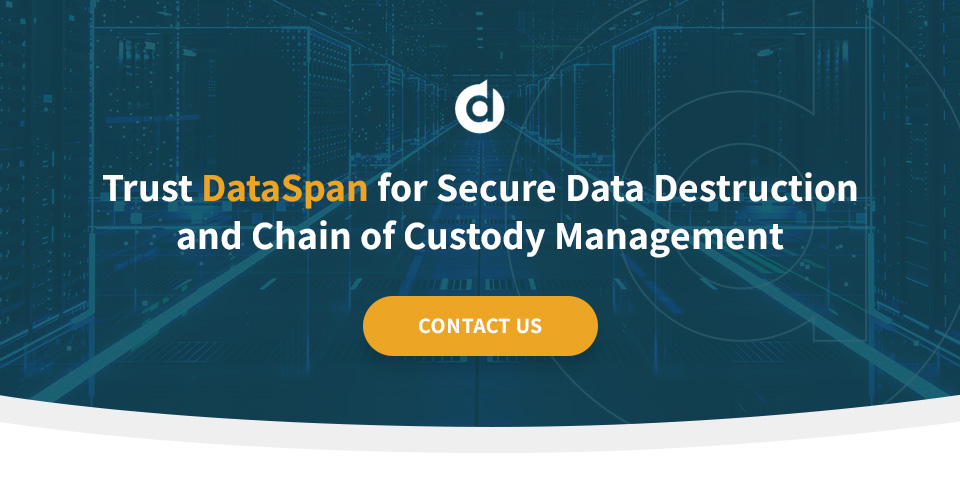
Fundamentals of Data Destruction: The Importance of Chain of Custody
Experts predict that the volume of data created by businesses doubles every two years. When you add the speed at which data centers are filled up, and IT equipment is replaced by newer iterations, you begin to see how important it is to properly destroy or render unusable any old equipment that may contain valuable or sensitive data.
Of course, data breaches don’t just occur online. And for businesses that might be audited or face legal repercussions if they can’t prove beyond a shadow of a doubt how and when their outdated equipment was decommissioned, there’s no substitute for working with a fully qualified data destruction company that supplies you with a secure chain of custody throughout the entire data destruction process.
Understanding the Chain of Custody
To understand chain of custody, you want to think of how you could legally prove that your old equipment, as well as the data it contained, was handled properly. From the moment it left your facility until it was destroyed in an electronic shredding procedure, thoroughly wiped clean of data or degaussed with a high-powered magnet, there must be complete, organized documentation of what happened to the equipment and data. Proper procedure tracking accurately verifies the data’s security throughout the eradication process.
This is why any worthwhile chain of custody gives you a complete paper trail — or digital trail — that forms a total history of who handled your equipment, where it was stored, how it was transported, and under what circumstances it was eventually destroyed or rendered unusable. There are many ways to destroy data from devices, and your ideal method typically depends on the nature of your industry, specific regulations and the type of data storage equipment in your facility. In addition, companies that use professional data destruction services are issued certificates of destruction upon completion of the process.
Why the Chain of Custody Is Crucial for Your Business

For many businesses — such as those that work with electronic health records or sensitive financial information — laws and regulations like HIPAA, Sarbanes-Oxley and Gramm-Leach-Bliley require the ability to produce a chain of custody that includes all issued certificates of destruction during an audit. Not complying with these federal regulations can have dramatic consequences for a business that wants to remain in operation and be competitive for the foreseeable future.
For instance, the Health Insurance Portability and Accountability Act (HIPAA) strictly protects patient medical records and personal health information. This privacy rule requires the health care industry to completely destroy all protected health information once it is no longer needed, along with the proper chain of custody documentation. Health care organizations are also specifically required to obtain the oversight of third-party data destruction services. Lack of compliance may result in significant monetary, civil or criminal penalties with mandatory corrective action.
The Risk of Inadequate Data Destruction and Chain of Custody Procedures
For a majority of businesses, the chain of custody is a legal requirement, not something you should take shortcuts with. This could expose your organization to preventable levels of risk across multiple regulatory frameworks and other protection laws. To have anything less than a robust chain of custody can leave your organization vulnerable to the following risks:
- Legal penalties: One of the main drawbacks of noncompliance with the chain of custody is the cost of legal penalties. Without a clear, documented trail of how data destruction is processed, the authenticity of the data’s eradication may be questioned, resulting in hefty legal fines.
- Audit challenges: Without a robust chain of custody documentation, internal and external audits become challenging and less effective. The inability to trace documents and identify accountability gaps stifles your organization’s efforts to ensure compliance.
- Data breaches: Lack of professional data destruction services increases the likelihood of data breaches. Sensitive data might be exposed to unauthorized parties, leading to serious security issues and significant financial loss. In 2024, data breaches cost companies an average of $4.88 million worldwide.
- Data tampering: Besides breaches, data may be exposed to tampering. Altered or falsified company data can hinder crucial decisions in your organization. It can also negatively impact your reputation with clients.
- Operational disruptions: Dealing with breaches can disrupt company operations, resulting in significant downtime. Your organization may struggle to contain and mitigate the breach, affecting productivity and business performance.
- Reputational damage: Inadequate chain of custody protocols can erode customer and stakeholder trust. Once compromised, rebuilding confidence becomes a difficult and costly challenge, which may lead to lost business opportunities.
For these reasons, it’s best to choose a AAA-certified National Association for Information Destruction (NAID) member company, such as DataSpan to complete data destruction services in a secure and compliant fashion. Professional data destruction services provide a well-documented chain of custody and effective destruction methods that help organizations demonstrate due diligence in protecting sensitive information while meeting their regulatory obligations.
Trust DataSpan for Secure Data Destruction and Chain of Custody Management
Upholding data protection is paramount in every data server facility, including properly handling old, excess and duplicate data in storage systems. DataSpan provides secure turnkey data destruction and eradication services to safeguard your company’s sensitive data. Gain peace of mind with customizable data elimination services, removing possible risks to data exposure with meticulous storage, inventory, wiping, degaussing and erasing to ensure your data is properly destroyed and inaccessible to unauthorized entities.
For over 50 years, it has been the sole mission of DataSpan to supply data centers with the equipment and professional services they need to stay competitive. In that time, we’ve earned the trust of more than half of the Fortune 1000 who are pleased members of our client list.
To learn more about data destruction services near you, please contact a local DataSpan rep today through our find your rep tool. You may also fill out our contact form to request more information.








